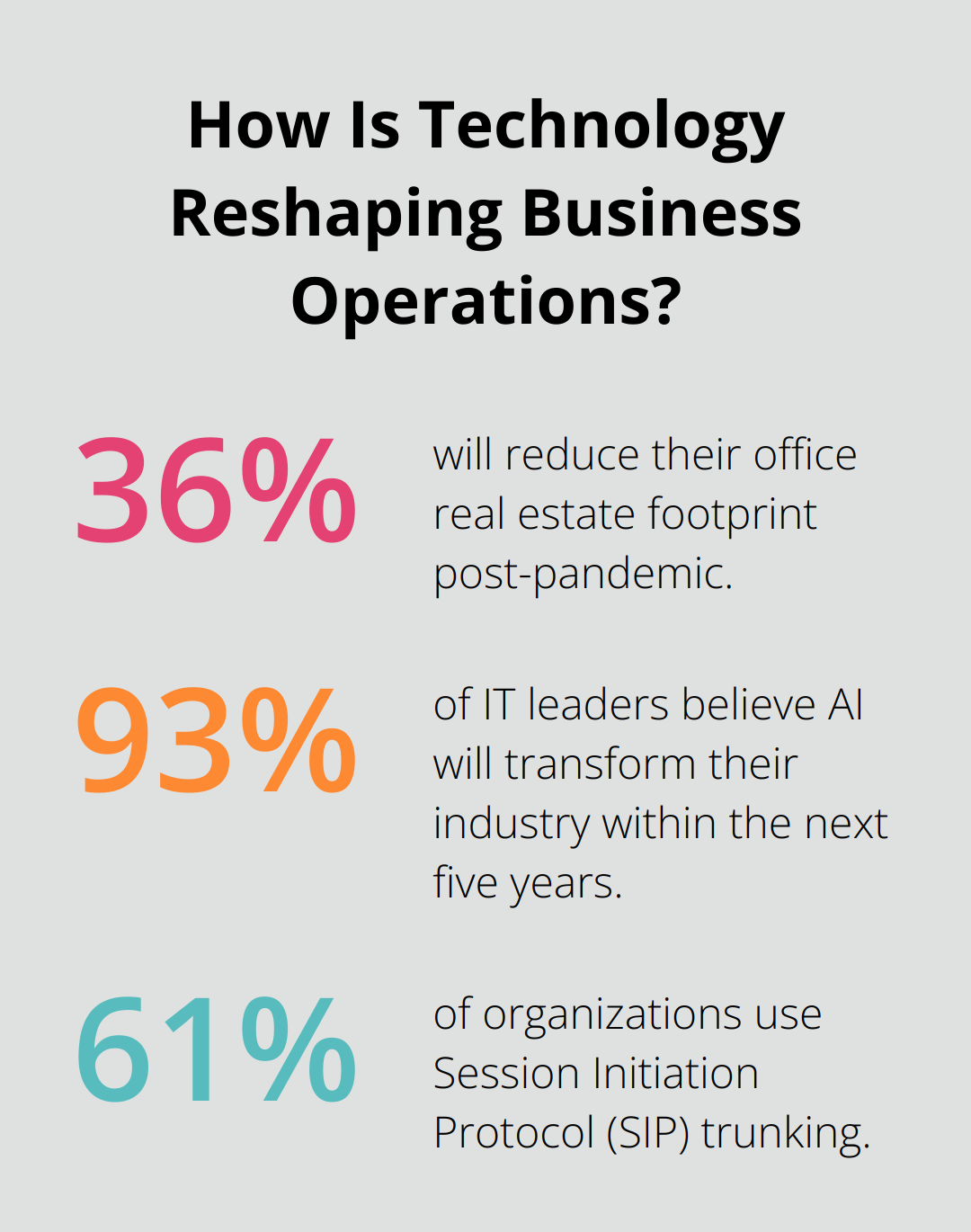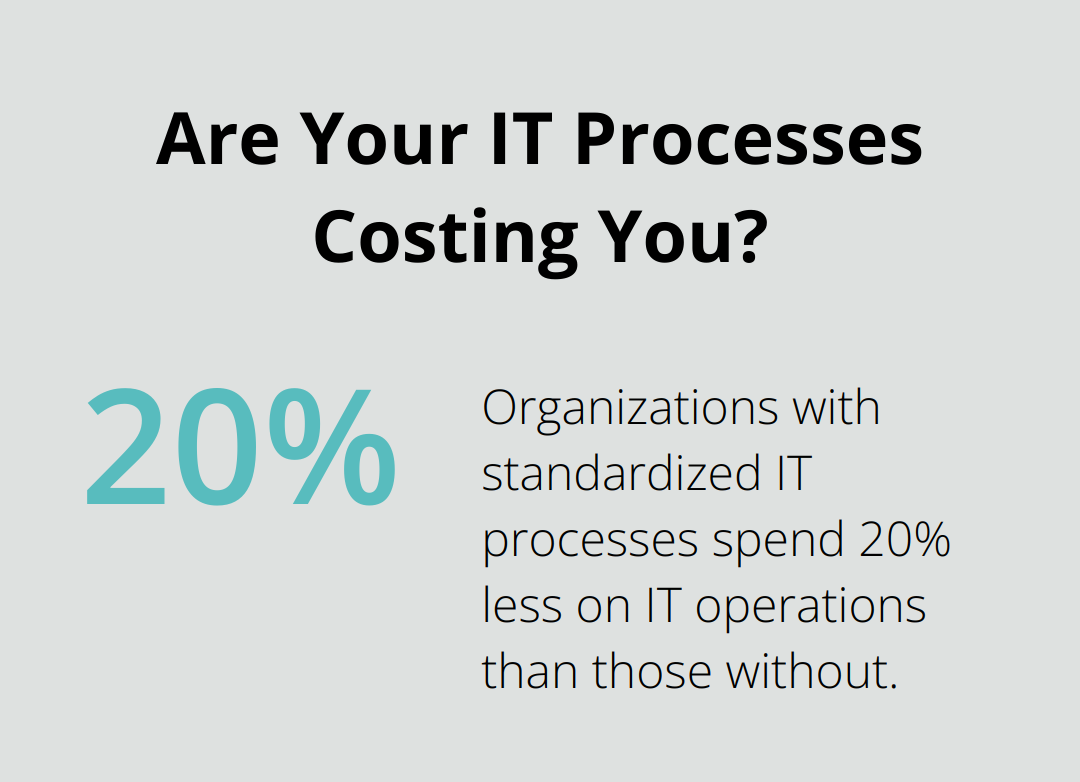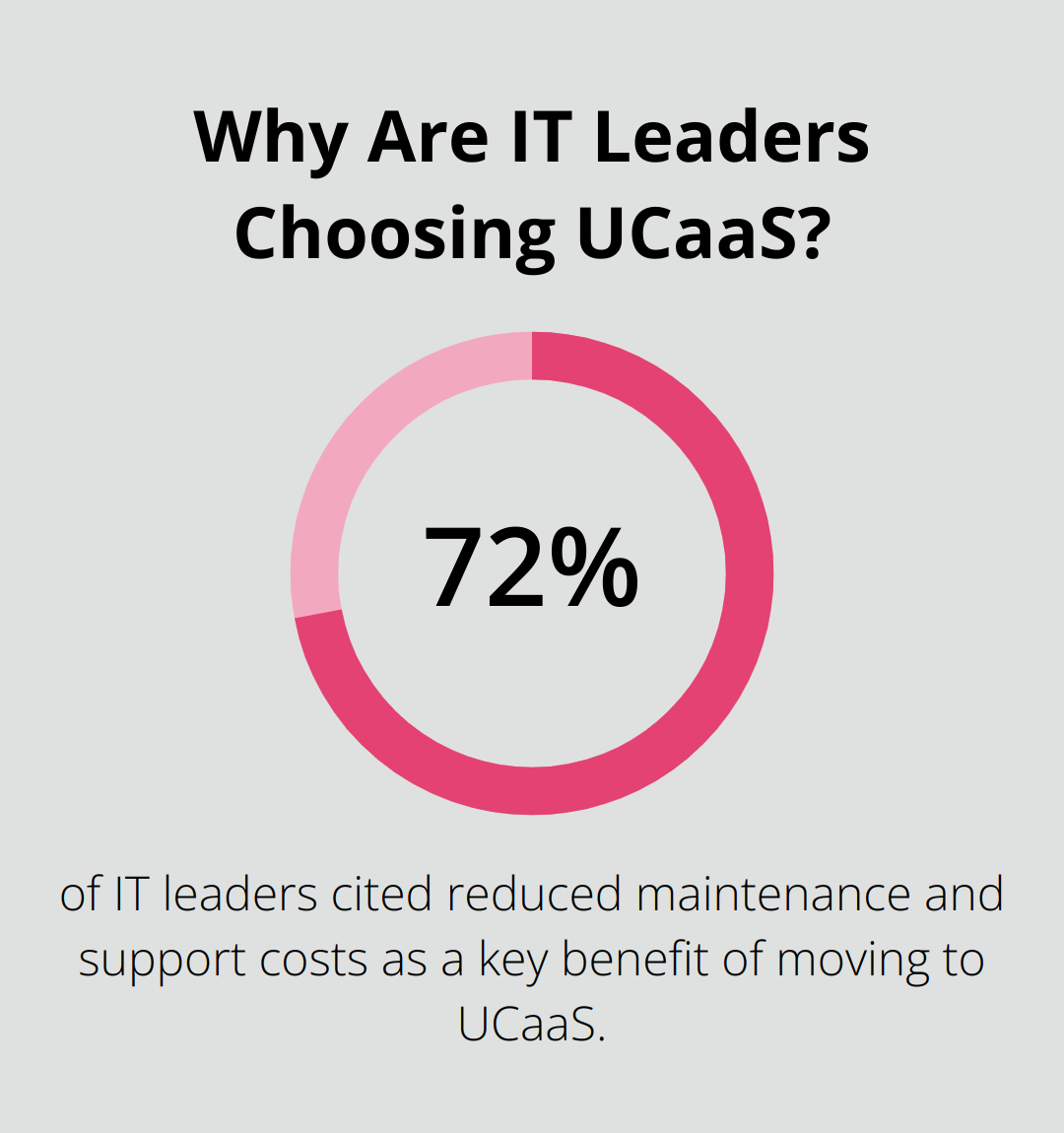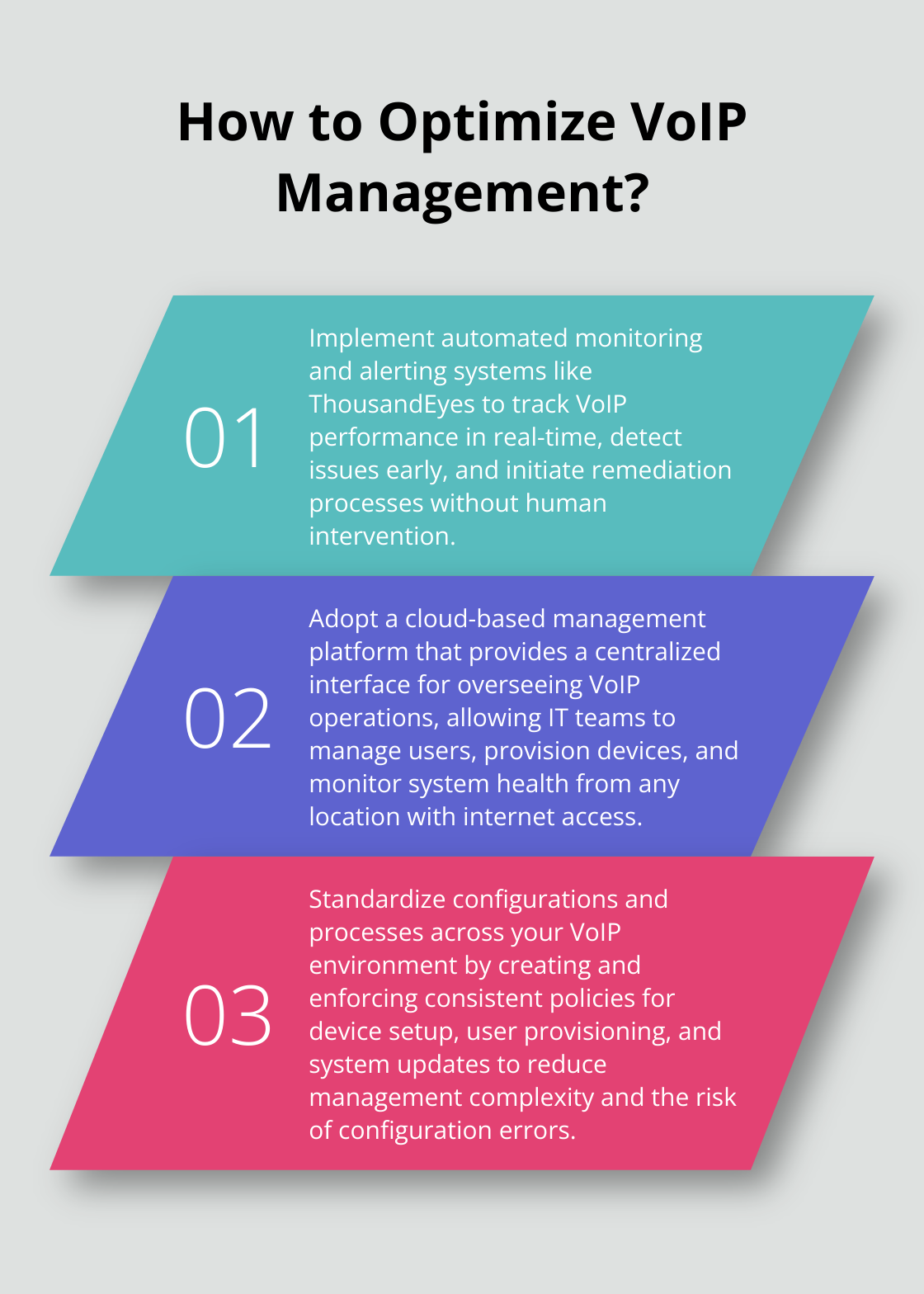VoIP management has become increasingly complex, putting a strain on IT teams already stretched thin. At UCaaS Review, we’ve seen firsthand how this challenge impacts businesses of all sizes.
In this post, we’ll explore effective strategies to streamline VoIP management, reducing the burden on IT departments. We’ll also examine how UCaaS solutions can simplify these processes, allowing IT teams to focus on innovation rather than maintenance.
Why VoIP Management Overwhelms IT Teams
The Expanding VoIP Ecosystem
Voice over Internet Protocol (VoIP) systems have transformed from simple phone replacements into complex ecosystems. VoIP systems now integrate with various business applications, support multiple communication channels, and require constant updates and security patches. A recent Frost & Sullivan study reveals that post-pandemic 36% will reduce their office real estate footprint and 37% will invest in collaboration tools, underscoring the widespread adoption of these intricate systems.

This complexity creates a steep learning curve for IT professionals. They must become experts in network infrastructure, security protocols, and a wide array of VoIP-specific technologies. For example, understanding Session Initiation Protocol (SIP) trunking (used by 61% of organizations according to an Eastern Management Group report) has become an essential skill for IT teams.
Resource Constraints in IT Departments
While VoIP management demands increase, IT departments often face budget and staffing limitations. A 2023 Spiceworks Ziff Davis survey found that 44% of IT professionals believe their department lacks adequate staffing. This shortage forces existing team members to juggle multiple responsibilities, often balancing VoIP management with other critical IT tasks.
Time constraints further compound the problem. According to an IDC study, IT teams spend an average of 30% of their time on routine maintenance tasks. This leaves little room for strategic initiatives or proactive improvements to VoIP systems.
The Innovation vs. Maintenance Dilemma
IT professionals face a constant struggle between maintaining existing systems and driving innovation. VoIP technologies evolve rapidly, with new features and capabilities emerging regularly. However, the daily demands of keeping current systems operational often prevent IT teams from exploring and implementing these innovations.
For instance, while 93% of IT leaders believe AI will transform their industry within the next five years (as reported by IBM), many struggle to find the time and resources to integrate AI-powered features into their VoIP systems. This gap between potential and reality often leads to frustration and a sense of falling behind for many IT departments.
The Role of UCaaS in Alleviating IT Burdens
Businesses that successfully navigate these challenges often turn to Unified Communications as a Service (UCaaS) solutions. These platforms can significantly reduce the management burden on IT teams while still providing access to cutting-edge VoIP features. UCaaS Review, a leading platform in this space, uses AI technology to match businesses with the best UCaaS providers in under three minutes, offering a streamlined approach to finding solutions that can ease IT workloads.
As we move forward, we’ll explore specific strategies for streamlining VoIP management, including how UCaaS can play a pivotal role in this process. These strategies will help IT teams reclaim their time and focus on driving innovation rather than just maintaining the status quo.
How to Simplify VoIP Management
VoIP management doesn’t have to overwhelm IT teams. Smart strategies and the right tools can significantly reduce the complexity of VoIP management. Here are practical approaches that make a real difference:
Automate for Proactive Management
Automated monitoring and alerting systems offer one of the most effective ways to streamline VoIP management. These tools continuously track system performance, identify potential issues before they escalate, and even initiate remediation processes without human intervention.

For example, solutions like ThousandEyes provide real-time insights into VoIP system performance, detecting issues and allowing for quick resolution before users notice them.
A report by MarketsandMarkets projects the global network automation market to grow from $2.9 billion in 2020 to $8.9 billion by 2025. This growth underscores the increasing recognition of automation’s value in managing complex networks (including VoIP systems).
Use Cloud-Based Management Platforms
Cloud-based management tools offer a centralized platform for overseeing VoIP operations, often with user-friendly interfaces that simplify complex tasks. These platforms provide a single pane of glass for managing multiple sites, users, and devices, reducing the time and effort required for routine administration.
A prime example is the management interface provided by cloud-based phone systems, which allows IT teams to manage users, provision devices, and monitor system health from any location with internet access. This flexibility proves particularly valuable in today’s distributed work environments.
Cloud-based phone systems are more cost-effective compared to traditional telephone systems. On average, a landline phone system costs businesses $50 per line.
Standardize Your VoIP Environment
Standardizing configurations and processes across your VoIP environment can dramatically reduce the complexity of management tasks. This approach involves creating and enforcing consistent policies for device setup, user provisioning, and system updates.
For instance, a standard operating procedure for onboarding new employees ensures that every user receives the correct permissions, features, and security settings from day one. This not only saves time but also reduces the risk of configuration errors that could lead to security vulnerabilities or performance issues.
Gartner reports that organizations with standardized IT processes spend 20% less on IT operations than those without. While this statistic covers IT operations broadly, it applies particularly to VoIP management given the system’s complexity and critical nature.
These strategies significantly reduce the time and effort required for VoIP management. This alleviates the burden on overworked staff and frees up resources for more strategic initiatives. As businesses continue to rely heavily on VoIP for communication, streamlined management processes become increasingly important for maintaining operational efficiency and driving innovation. The next section will explore how Unified Communications as a Service (UCaaS) solutions further simplify VoIP management and benefit IT teams.
How UCaaS Simplifies VoIP Management
Unified Communications as a Service (UCaaS) is a cloud-based model that helps companies manage their communications easily and efficiently. These cloud-based platforms integrate various communication tools, including VoIP, video conferencing, and instant messaging, into a single, manageable system.
Centralized Management and Reduced Complexity
UCaaS platforms provide a centralized management interface, allowing IT teams to oversee all communication tools from a single dashboard. This consolidation simplifies administrative tasks and reduces the time spent managing multiple systems. A study by Nemertes Research found that organizations using UCaaS spend $1153 per license annually, while those on premises spend $1830.

The cloud-based nature of UCaaS eliminates the need for on-site hardware management. IT teams no longer need to worry about server maintenance, software updates, or hardware replacements. UCaaS providers handle these tasks, freeing up valuable time and resources. A survey by Frost & Sullivan revealed that 72% of IT leaders cited reduced maintenance and support costs as a key benefit of moving to UCaaS.
Enhanced Security and Compliance
UCaaS solutions often include built-in security features and compliance measures, alleviating a significant burden from IT teams. These platforms typically offer end-to-end encryption, regular security updates, and compliance with industry standards like HIPAA and GDPR.
For example, leading UCaaS providers offer enterprise-grade security features including TLS and SRTP encryption, single sign-on, and role-based access control. These built-in security measures reduce the pressure on IT teams to implement and maintain complex security protocols independently.
Scalability and Flexibility
UCaaS platforms excel in scalability, allowing businesses to easily add or remove users, features, and services as needed. This flexibility proves particularly valuable for growing businesses or those with fluctuating communication needs. IT teams can quickly provision new users or adjust service levels without complex hardware installations or software configurations.
Some UCaaS providers allow businesses to scale from 10 to 10,000 users seamlessly, with no need for additional on-premises equipment. This scalability not only simplifies management but also ensures that businesses only pay for the services they need.
Choosing the Right UCaaS Provider
Selecting an appropriate UCaaS provider is essential for maximizing these benefits. When evaluating providers, consider factors such as:
- Feature set: Ensure the platform offers all the communication tools your organization needs.
- Integration capabilities: Look for providers that integrate well with your existing business applications.
- Reliability and uptime: Check the provider’s Service Level Agreements (SLAs) and uptime guarantees.
- Support options: 24/7 support can prove invaluable for maintaining smooth operations.
- Pricing structure: Understand the pricing model and ensure it aligns with your budget and usage patterns.
UCaaS Review stands out as an excellent resource for businesses navigating this selection process. Their AI-powered platform quickly matches organizations with suitable UCaaS providers based on specific requirements, saving time and ensuring a good fit.
Final Thoughts
VoIP management doesn’t have to burden IT teams. Automated monitoring systems, cloud-based tools, and standardized processes streamline VoIP operations. These strategies reduce complexity and allow IT professionals to focus on innovation and strategic initiatives.

Unified Communications as a Service (UCaaS) solutions simplify IT workloads significantly. UCaaS platforms offer centralized management, enhanced security, and scalability, addressing many challenges faced by IT departments. They consolidate communication tools into a single, manageable system, which reduces time spent on routine maintenance.
IT teams should regularly assess their VoIP management practices and adapt to new technologies. UCaaS Review matches businesses with suitable providers quickly (using AI technology). Organizations can transform VoIP management from a challenge into an efficient process that supports IT innovation.



